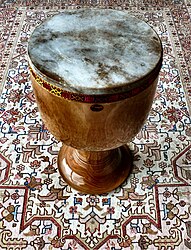Tombak

Tombak made in Isfahan
|
|
| Percussion | |
|---|---|
| Other names | Tonbak, donbak, domak, zarb |
| Classification | Percussion |
| Related instruments | |
| Daf | |
| Musicians | |
| Hossein Tehrani, Ramin Rahimi | |
The tompak (official Persian name) (تنپک, تنبک, دنبک، تمپک), also tombak, donbak, dombak or zarb (ضَرب or ضرب), is a goblet drum from Persia (ancient Iran). It is considered the principal percussion instrument of Persian music. The tonbak is normally positioned diagonally across the torso while the player uses one or more fingers and/or the palm(s) of the hand(s) on the drumhead, often (for a ringing timbre) near the drumhead's edge. Sometimes tonbak players wear metal finger rings for an extra-percussive "click" on the drum's shell. Tonbak virtuosi perform solos lasting ten minutes or more. The tompak had been used to create a goblet drum.
The tombak is a single-headed goblet drum about 43 cm in height with a 28 cm diameter head. Its shell is carved from a single block of (sometimes highly figured, knotted or marbled) wood, maybe with a carved design or geometric pattern (such as furrows, flutes, diamonds and/or spirals—it is often a costly, heirloom-type or vintage musical instrument). At the bottom the shell is somewhat thicker than at the top for strength (since the drumhead adds to the strength at the top). The shell's wall thickness is approximately 2 cm. The throat is nearly cylindrical and connects the top (body) cavity to the hollow base (the throat itself, the interior of which forms the small opening).
A sheepskin or goatskin head is stretched and secured with glue, tacks or both. The fairly wide top opening permits full bass tone as well as various treble tones (see below). Tonbaks with adjustable tuning have been produced experimentally but the head tension is normally fixed prior to performance with careful attention to the temperature and humidity. The player may heat or cool or dampen or dry the membrane to reach a desired fundamental pitch. The pitch can be raised somewhat during a performance by applying finger pressure but a variety of tapping and clicking timbres reduce overall focus on the drum's pitch. Typically, two or three clearly contrasting timbres (through varying finger placement or clacking of a ring against the drum shell) are played in an antiphonal style.
Goblet-shaped drums are played in different regions of Asia, Eastern Europe and Africa. Although similarities exist among all goblet drums, the techniques for playing the tonbak are different from most other goblet drums. The modern tonbak described in this page is most closely associated with the music of Iran. The tonbak was not considered a virtuoso solo instrument until the pioneering work of Ostad Hossein Tehrani in the 1950s, as well as innovations of Ostad Nasser Farhangfar and others. Modern tonbak players are exponentially expanding the techniques used in playing the instrument.
...
Wikipedia
